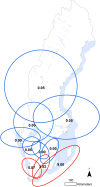Surveys on Coxiella burnetii infections in Swedish cattle, sheep, goats and moose
- PMID: 25007979
- PMCID: PMC4112654
- DOI: 10.1186/1751-0147-56-39
Surveys on Coxiella burnetii infections in Swedish cattle, sheep, goats and moose
Abstract
Background: Q fever is a zoonotic disease caused by the bacterium Coxiella burnetii. Prevalence data in ruminant species are important to support risk assessments regarding public and animal health. The aim was to investigate the presence of or exposure to C. burnetii in cattle, sheep, goats and moose, and to compare two enzyme-linked immunosorbent assays (ELISAs). National surveys of antibodies against C. burnetii were performed for dairy cattle (n=1537), dairy goats (n=58) and sheep (n=518). Bovine samples consisted of bulk milk, caprine of pooled milk, and ovine of pooled serum. Antibodies were investigated in moose samples (n=99) from three regions. A one-year regional cattle bulk milk survey was performed on the Isle of Gotland (n=119, four occasions). Cattle, sheep and goat samples were analysed with indirect ELISA and moose samples with complement fixation test. For the sheep, goat, and parts of the cattle survey, samples were run in parallel by ELISAs based on antigens from infected ruminants and ticks. Bulk milk samples from the regional cattle survey and vaginal swabs from a subset of the sheep herds (n=80) were analysed for the agent by polymerase chain reaction. Spatial clustering was investigated in the national cattle survey.
Results: The prevalence of antibodies in dairy herds was 8.2% with large regional differences. High risk clusters were identified in the southern regions. The prevalence among dairy herds on the Isle of Gotland varied from 55.9% to 64.6% and 46.4% to 58.9.0% for antibodies and agent, respectively, overall agreement between agent and antibodies was 85.2%. The prevalence of antibodies in sheep was 0.6%, the agent was not detected the vaginal swabs. Antibodies were not detected in goats or moose, although parts of the moose samples were collected in an area with high prevalence in cattle. The overall agreement between the two ELISAs was 90.4%.
Conclusions: The prevalence of antibodies against C. burnetii in dairy cattle in Sweden shows large regional differences. The results suggest that C. burnetii is a rare pathogen among Swedish moose, dairy goat and sheep. ELISAs based on ruminant and tick antigen performed in a similar manner under Swedish conditions.
Figures



Similar articles
-
Detection of Coxiella burnetii by nested PCR in bulk milk samples from dairy bovine, ovine, and caprine herds in Iran.Zoonoses Public Health. 2010 Dec;57(7-8):e38-41. doi: 10.1111/j.1863-2378.2009.01289.x. Zoonoses Public Health. 2010. PMID: 19968851
-
Seroprevalence of Coxiella burnetii Antibodies Among Ruminants and Occupationally Exposed People in Thailand, 2012-2013.Am J Trop Med Hyg. 2017 Apr;96(4):786-790. doi: 10.4269/ajtmh.16-0336. Epub 2017 Jan 23. Am J Trop Med Hyg. 2017. PMID: 28115661 Free PMC article.
-
Genotyping of Coxiella burnetii from domestic ruminants in northern Spain.BMC Vet Res. 2012 Dec 10;8:241. doi: 10.1186/1746-6148-8-241. BMC Vet Res. 2012. PMID: 23227921 Free PMC article.
-
Q fever and seroprevalence of Coxiella burnetii in domestic ruminants.Vet Ital. 2018 Dec 31;54(4):265-279. doi: 10.12834/VetIt.1113.6046.3. Vet Ital. 2018. PMID: 30681125 Review.
-
Coxiella burnetii infections in sheep or goats: an opinionated review.Vet Microbiol. 2015 Dec 14;181(1-2):119-29. doi: 10.1016/j.vetmic.2015.07.011. Epub 2015 Jul 15. Vet Microbiol. 2015. PMID: 26315774 Review.
Cited by
-
Sources of spatial animal and human health data: Casting the net wide to deal more effectively with increasingly complex disease problems.Spat Spatiotemporal Epidemiol. 2015 Apr;13:15-29. doi: 10.1016/j.sste.2015.04.003. Epub 2015 May 8. Spat Spatiotemporal Epidemiol. 2015. PMID: 26046634 Free PMC article. Review.
-
Estimation of the frequency of Q fever in sheep, goat and cattle herds in France: results of a 3-year study of the seroprevalence of Q fever and excretion level of Coxiella burnetii in abortive episodes.Epidemiol Infect. 2017 Nov;145(15):3131-3142. doi: 10.1017/S0950268817002308. Epub 2017 Oct 17. Epidemiol Infect. 2017. PMID: 29039279 Free PMC article.
-
Latent class evaluation of the performance of serological tests for exposure to Brucella spp. in cattle, sheep, and goats in Tanzania.PLoS Negl Trop Dis. 2021 Aug 24;15(8):e0009630. doi: 10.1371/journal.pntd.0009630. eCollection 2021 Aug. PLoS Negl Trop Dis. 2021. PMID: 34428205 Free PMC article.
-
Prevalence and associated risk factors of anti-Coxiella burnetii antibodies in dairy cattle herds using bulk tank milk analysis in Kabylia area, north Algeria.Trop Anim Health Prod. 2024 Mar 20;56(3):106. doi: 10.1007/s11250-024-03950-y. Trop Anim Health Prod. 2024. PMID: 38507146
-
Coxiella burnetii (Q fever) infection in dairy cattle and associated risk factors in Latvia.Epidemiol Infect. 2017 Jul;145(10):2011-2019. doi: 10.1017/S0950268817000838. Epub 2017 May 2. Epidemiol Infect. 2017. PMID: 28462725 Free PMC article.
References
-
- Enright J, Franti C, Behymer D, Longhurst W, Dutson V, Wright M. Coxiella burnetii in a wildlife-livestock environment–distribution of Q fever in wild mammals. Am J Epidemiol. 1971;94:79–90. - PubMed
Publication types
MeSH terms
Substances
LinkOut - more resources
Full Text Sources
Other Literature Sources

